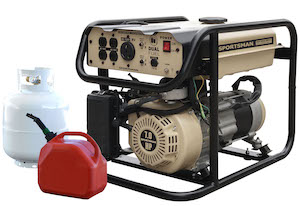Rental Solutions: Multi-fuel generators
Consider adding dual or hybrid power units to your rental fleet.
by Rick Salvo
Small/compact generator products are generally market-segmented at less than 5kW. the 5 to 10kW units are further segmented by fuel types: gasoline, diesel, natural gas, LPG, propane, bio-diesel and dual or tri-fuel.
 |
| The increased focus on environment-friendly technologies around the world is driving the generator market overall for LPG-, propane-, and bio-diesel fuel-based portable generators. There is an emerging product trend for dual-fuel hybrid generators rated at 3 to 10 kW that are almost always gasoline/propane type models. |
The increased focus on environment-friendly technologies around the world is driving the generator market overall for LPG-, propane-, and bio-diesel portable generators.
There is an emerging trend for dual-fuel hybrid generators rated at 3 to 10 kW that are almost always gasoline/propane type models. For tri-fuel offerings at 10 kW, fewer models are available and are almost always configured as gasoline/natural gas/LPG.
According to recent market reports, the 5 to 10 kW segment will be the fastest growing segment over the next several years. These portable generators can also handle a huge amount of load from other equipment, like recharging batteries, portable/temporary lighting, fans, radios and more.
Fuel flexibility
One of the biggest reasons people prefer the dual- or even tri-fuel generators is the convenience from fuel flexibility. A single-fuel generator runs off of one fuel: natural gas, propane, gasoline or diesel. A natural gas or propane portable generator may be difficult to refuel because these fuel types might not be readily available. However, propane or natural gas burns cleaner than the more accessible diesel or gasoline fuels and sometimes desired on job sites.
A diesel-powered generator is more efficient but is not easily adapted to be used as a dual- or tri-fuel generator. The other fuel sources are less efficient, with propane being second in efficiency, gasoline third, and natural gas, fourth.
Uncertainty fuels demand
The increasing frequency of power grid failures over the next several years may accelerate the demand for dual-fuel generators. Overall, diesel as a fuel source for generators is gradually losing its popularity when compared with natural gas or propane because these fuel sources are cleaner. Additionally, having a dual-fuel gen set provides more fuel flexibility, which further contributes to their demand.
Dual-fuel generators are increasingly adopted by preppers or survivalists who need to prepare for emergency situations. There is always a possibility the required fuel source may become scarce at any time during a time of critical need, and therefore, in the future, most people will tend to purchase a generator that can be operated using two or three different fuels.
According to Technavio in its January 2019 report, Global Dual Fuel Generator Market 2019-2023, the growth of microgrid networks, the increasing adoption of the rental model and the fluctuations in the prices of crude oil are some of the major aspects that are contributing largely to the growth of this global market through 2023.
As construction business owners become more energy conscious or “green” driven, they may seek to use these portable 3 to 10 kW dual-fuel hybrid gen sets on their job sites. In cold climates, they may already have an economical propane source to fuel propane job site heaters. Because propane is a low-carbon fuel, construction professionals who use propane-powered heaters may find adopting dual-fuel generators attractive and offers them more flexibility in fuel sourcing to power tools, temporary lighting or recharge batteries.
If they are driven by “green” energy, by using propane as much as possible to power their generator, they will help to maintain a cleaner environment without sacrificing power or performance.
Stringent government regulations for diesel and gasoline-powered portable generators along with high operational and maintenance costs are leading restraints for portable generators. Therefore, they are driving some of the introduction and adoption of dual- and multi-fuel models. Further, dual fuel generators typically cost at least $100 or more than their single-fuel counterpart; less common tri-fuel models cost even more.
Early adopters for small dual-fuel hybrid generators will likely be equipment rental companies and business owners who want the flexibility and convenience of choosing whether to use gasoline and propane. These buyers will likely be decision makers that are driven by environmental greening and decreasing their carbon footprint.
Another factor restraining the growth of the portable generator market is the increased adoption of energy storage technologies. If a construction company owner wants to minimize generator run time and fuel use, adding a battery bank could accomplish that. However, the owner may be hesitant to invest in then unless the units demonstrate a good return on investment.
Hybrid renewable energy systems should be sized so that the total amount of daily charging energy from all sources – generator, solar photovoltaic or wind – exceeds the job site’s total average daily load. The role of the small portable gen set in this scenario is to provide direct power or recharge a battery bank that is part of a hybrid power system configuration.
Rick Silva is senior systems engineer at Custom Manufacturing and Engineering, www. custom-mfg-eng.com.
Copyright 2019 Urbain Communications, LLC. All rights reserved. Contact curbain@urbaincomm.com for permission to reprint or rebroadcast all or part of this article.










